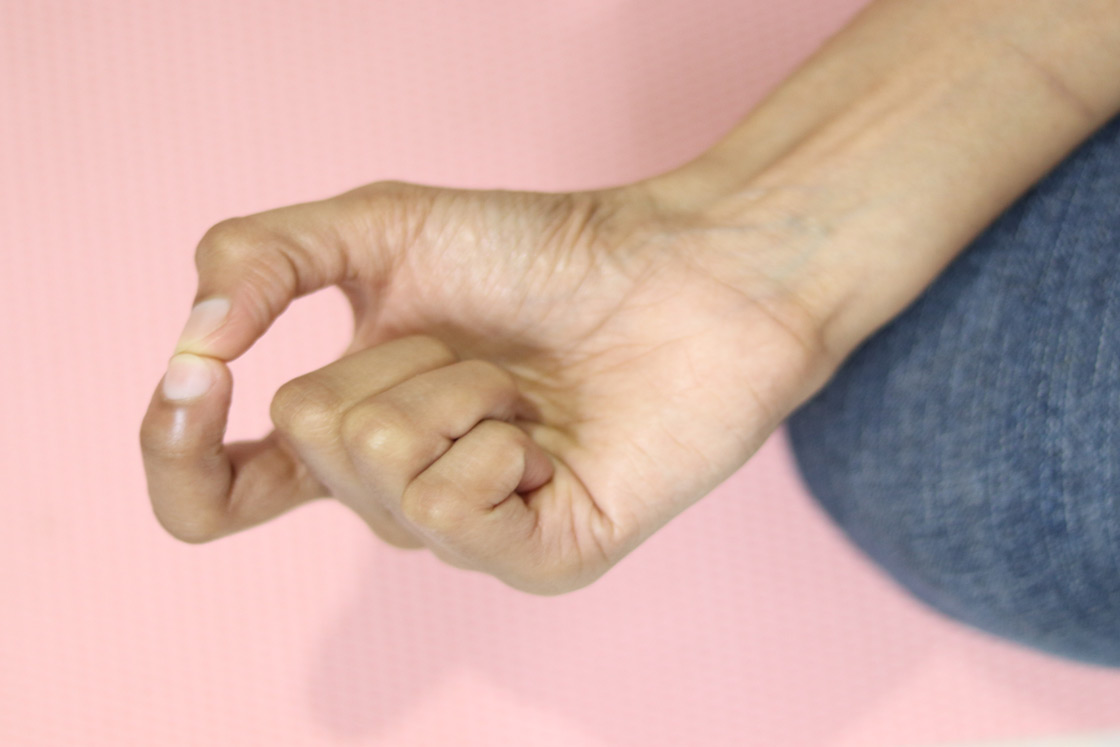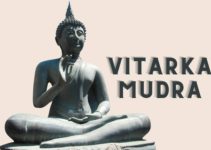
The Sanskrit word Chinmaya means supreme awareness, full of knowledge or pure wisdom and mudra means ‘gesture’; typically we form with our hands in yoga practice.
In this article, we will see the benefits of Chinmaya mudra and how to use it in pranayama effectively.
Chinmaya Mudra Meaning
Chinmaya mudra is a hand mudra of yoga with the thumb and the index finger. In English translation, Chinmaya mudra means “Gesture of Awareness” as it brings our outward flowing awareness back to the body.
Through this mudra, the body becomes more aware of breathing and with breath awareness, prana energy flows smoothly in the body. It helps to clear the mental chaos and thereby the physical body to remain in balance. It also helps build self-confidence and trust in yourself and the world around you.
Spiritually, chinmaya mudra helps us understand our life priorities by enhancing internal awareness. It prompts us to understand the basis of our fears, anxiety, and losses. Through this awareness, you can quieten the mind from many worries and target your thoughts to what is important.
Also read: 8 Ways to increase prana energy in the body
Use and significance of chinmaya mudra
Chinmaya mudra practice is done by curling the three fingers (middle finger, ring finger and little finger) inwards to the palm while the tips of the index and thumb are in contact. Then, hands with this mudra are placed on the knees in either palm facing upwards or downwards.
The position of the hand in Chinmaya mudra is such that the respective elements of the five fingers come together. That is, in this mudra all the five elements of the body are joined together. More especially, it unites individual consciousness and universal consciousness by joining the index finger and thumb. It balances the fire and air element.
Different elements and representations associated with five fingers are;
- Thumb– Fire element or Universal consciousness
- Index finger– Air element or individual consciousness
- Middle finger– Ether element or Connection
- Ring finger– Earth element or physical sensation
- Little finger– Water element or fluidity
The union of all five fingers ensures the inward flow of awareness; Our awareness which is normally dissipated into the outside world through various means starts flowing inwardly to the body with chinmaya mudra.
The practice of chinmaya mudra is mainly done with pranayamas like kapalbhati and ujjayi to keep the body in a balanced state while regulating the breath. It’s also used in om chanting.
Also read: How to correctly chant OM: Step-by-step guide
Benefits of Chinmaya Mudra
Chinmaya mudra is one of the powerful hand mudras for physical and mental health because it helps attain a certain level of awareness. It promotes the smooth flow of breathing which helps the body to remain in balance during pranayama and meditation. This mudra is good to relieve stress and anxiety, inducing sleep, and enhancing memory.
In the below points, we have described the main benefits of chinmaya mudra;
- Helps gain awareness. Chinmaya Mudra helps in clearing the mind and a flow of awareness through the contact of the thumb and index finger. It aids in building our connection with the supreme soul.
- Opens blockages of thoracic region. Chinmaya mudra promotes breathing in the middle chest, back, and lobs of the lungs which regulate the energy of throat chakra.
- Prevents memory loss. Regular practice of chinmaya mudra boosts the flow of prana energy towards the brain which relaxes the brain and enhances the functioning of the nerves of the brain.
- Improves digestive function. When the flow of prana energy improves, it also positively affects the functioning of the digestive system by increasing the rate of metabolism.
- Alleviates stress and anxiety. Chinmaya mudra aids in finding the root cause of problems within us instead of looking outwards. This internal awareness is one of the main causes of reduced anxiety and stress levels.
- Cures insomnia and improves the quality of sleep. The practice of chinmaya mudra doesn’t let our awareness be scattered to the outer world. It calms the mind by reducing stress and encourages looking inwards which is great for inducing sleep.
- Promotes humbleness and grounding. Chinmaya mudra gives wisdom and knowledge which removes all sense of ego and pride. It makes you surrender to the divine that keeps you humble and grounded.
Read more: 5 mudras to improve your digestion
Steps to perform Chinmaya Mudra

Practising Chinmaya mudra early in the morning will be extremely beneficial as it is the best time for meditative practices. The serene environment before dawn will prompt you to look deeply inwards and self-reflect. However, it can also be in the evening time.
You can also chant a bija mantra to compliment and increase the power of this mudra.
Just like other yoga mudras, practice chinmaya mudra for 45 minutes at a stretch or divide it into 3 sessions of 10-15 minutes each throughout the day.
Let us see chinmaya mudra steps:
- Sit in a comfortable meditative pose such as Padmasana (lotus pose), Shukhasana (easy pose), or Vajrasana (thunderbolt pose), keeping the spine straight. Sit on a chair in case you can’t sit on the floor.
- Close your eyes and curl your fingers of both hands into a fist. Place your fists on your knees, palms facing up.
- Bring out the index and thumb and join them at the tips. Let the remaining fingers stay in their position.
- Keep hands in this mudra for the entirety of the meditation. You may also chant OM or an affirmation to enhance the effects of the mudra.
- When done as a standalone practice, do this mudra for at least 10 minutes.
- Once completed, detach your index and thumb and uncurl the rest of your fingers.
- Keep sitting in the meditative position for some minutes to assimilate the after-effects of the meditation session.
Also read: Tips to perform mudras effectively: A complete guide to yoga mudras
Chinmaya Mudra Vs. Chin Mudra
Chinmaya mudra sounds similar to chin mudra. There is a huge difference between the two in terms of their finger formation as well as their purpose.
Both chinmaya mudra and Chin mudra are practised by joining the tip of the index and thumb. However, in chinmaya mudra, the remaining fingers are curled inwards, into a fist. whereas, in chin mudra, the remaining fingers are kept stretched and straight.
Secondly, chinmaya mudra focuses on internal awareness while chin mudra is for generating self-consciousness.
To differentiate, awareness means to have the knowledge of the existence of something. It is not necessary that you may have a full understanding or knowledge of the subject. But when you have a complete in-depth understanding of the subject, you are not only fully aware of it but also develop consciousness. This means that awareness is a prerequisite for consciousness.
Conclusion
Being aware of oneself is one of the stepping stones on the path of spirituality. It is a way of attaining and enhancing wisdom and universal knowledge, that helps with removing ego. The humbleness and self-awareness you attain with chinmaya mudra will aid in bringing your closer to the universal truth and getting to know your true self.





Extremely interesting. Why would anyone do another mudra if this is a rejuvenator of so many major body systems?
As we have described Chinmaya mudra is the gesture of awareness. You can be aware of things with much awareness by the practice of this mudra but what if there isn’t that level of consciousness available within you? It doesn’t mean with awareness you’ll not become more conscious but to enhance your consciousness to a greater extent, there are other mudras, like Gyan mudra.
So, one should practice other mudras as well in complement to a specific mudra.